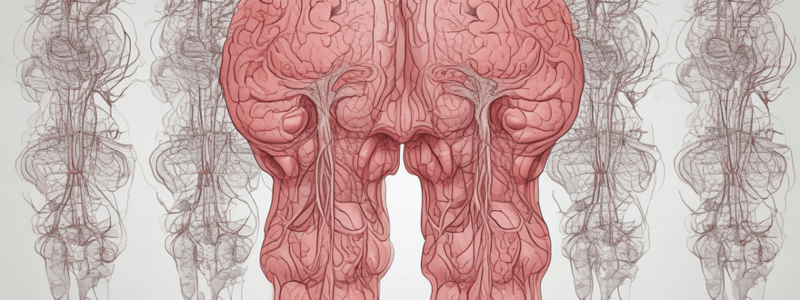Podcast
Questions and Answers
What happens to the average patient for every minute a large vessel ischemic stroke is left untreated?
What happens to the average patient for every minute a large vessel ischemic stroke is left untreated?
- Loses 1.9 million neurons
- Loses 13.8 billion synapses
- Loses 12 km (7 miles) of axonal fibers
- All of the above (correct)
Why is a 12-lead ECG not necessary at this stage for Adaibaa?
Why is a 12-lead ECG not necessary at this stage for Adaibaa?
- A 12-lead ECG would delay treatment further
- Adaibaa's symptoms are not severe enough
- Time is of the essence and a rhythm strip is sufficient (correct)
- A 12-lead ECG is not necessary for stroke diagnosis
What is the primary reason for maintaining SpO₂ greater than 94% in Adaibaa?
What is the primary reason for maintaining SpO₂ greater than 94% in Adaibaa?
- To provide adequate oxygenation (correct)
- To ensure proper brain function
- To slow down neuronal loss
- To prevent further brain damage
Why should aspirin not be given to Adaibaa at this stage?
Why should aspirin not be given to Adaibaa at this stage?
What is the primary goal of immediate actions in Adaibaa's case?
What is the primary goal of immediate actions in Adaibaa's case?
What is the significance of Adaibaa's blood glucose level taken in the ambulance?
What is the significance of Adaibaa's blood glucose level taken in the ambulance?
What is the primary goal for blood glucose levels in patients with acute stroke?
What is the primary goal for blood glucose levels in patients with acute stroke?
Why is the NIH Stroke Scale assessment important in stroke patients?
Why is the NIH Stroke Scale assessment important in stroke patients?
What is the significance of Adaibaa's partial gaze palsy that can be overcome?
What is the significance of Adaibaa's partial gaze palsy that can be overcome?
What is the primary reason for Adaibaa's difficulty in managing her medications?
What is the primary reason for Adaibaa's difficulty in managing her medications?
What is the significance of Adaibaa's complete hemianopia?
What is the significance of Adaibaa's complete hemianopia?
Why is HCG not relevant for this patient?
Why is HCG not relevant for this patient?
What is the significance of Adaibaa's inability to raise her right arm to 45 degrees?
What is the significance of Adaibaa's inability to raise her right arm to 45 degrees?
What is the primary purpose of conducting a cardiac rhythm strip in Adaibaa?
What is the primary purpose of conducting a cardiac rhythm strip in Adaibaa?
What is the significance of Adaibaa's fragmented language expression?
What is the significance of Adaibaa's fragmented language expression?
Why is arterial blood gas not indicated for this patient?
Why is arterial blood gas not indicated for this patient?
Flashcards are hidden until you start studying
Study Notes
Stroke Overview
- Stroke occurs when the blood supply to part of the brain is interrupted, affecting mobility, speech, language, cognition, and mood.
- There are two main types of stroke: ischemic (obstruction in a blood vessel) and hemorrhagic (weakened blood vessel rupture).
Importance of Rapid Treatment
- Every minute of untreated large vessel ischemic stroke results in the loss of 1.9 million neurons, 13.8 billion synapses, and 12 km of axonal fibers.
- Each hour without treatment, the brain loses neurons equivalent to 3.6 years of normal aging.
Adaibaa's Case
- Adaibaa, 67, presents with right face, arm, and leg weakness and numbness, unable to speak, with symptoms starting suddenly at 1 pm.
- Blood glucose level is 5.6 mmol/L (100 mg/dL).
- Medical history includes mild cognitive impairment, hypertension, atrial fibrillation, and difficulty managing medications.
Immediate Actions
- Activate stroke alert.
- Maintain SpO₂ > 94%.
- Create IV access.
- Activate transport.
- Keep patient NPO.
- Check vital signs (glucose, blood pressure, heart rate).
- Conduct NIH Stroke Scale assessment.
- Obtain collateral history.
- Obtain cardiac rhythm strip.
- Conduct blood tests.
Examination Results
- Blood pressure: 145/88 mm Hg.
- Heart rate: 110 beats per minute, irregular.
- Temperature: 36.5 ℃.
- O₂ saturation: 99% on room air.
- Respiratory rate: 18 breaths per minute.
- Blood glucose: 5.6 mmol/L (100 mg/dL).
NIH Stroke Scale (NIHSS)
- A bedside assessment tool evaluating acute cerebral infarction's effects on consciousness, language, neglect, visual-field loss, extraocular movement, motor strength, ataxia, dysarthria, and sensory loss.
- Predicts short- and long-term outcomes in stroke patients.
Adaibaa's NIHSS Assessment
- Alert and keenly responsive, but aphasic.
- Partial gaze palsy, which can be overcome.
- Complete hemianopia.
- Partial paralysis of the lower face.
- Able to perform finger-nose-finger test.
- Ataxia in one limb (right leg).
- Duller sense of touch.
- Fragmentary expression with inference needed.
- Slurred speech, but understandable.
Studying That Suits You
Use AI to generate personalized quizzes and flashcards to suit your learning preferences.




